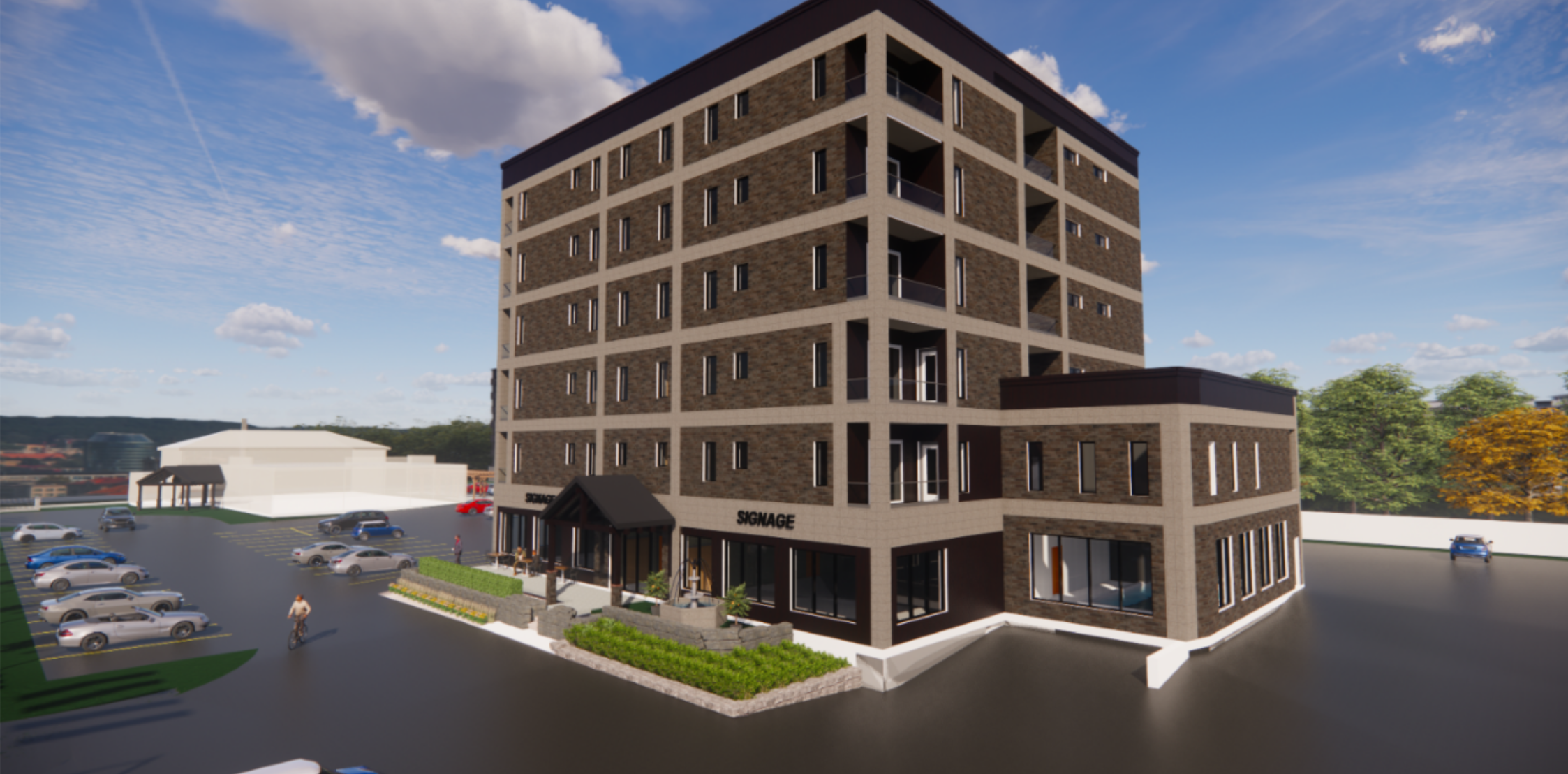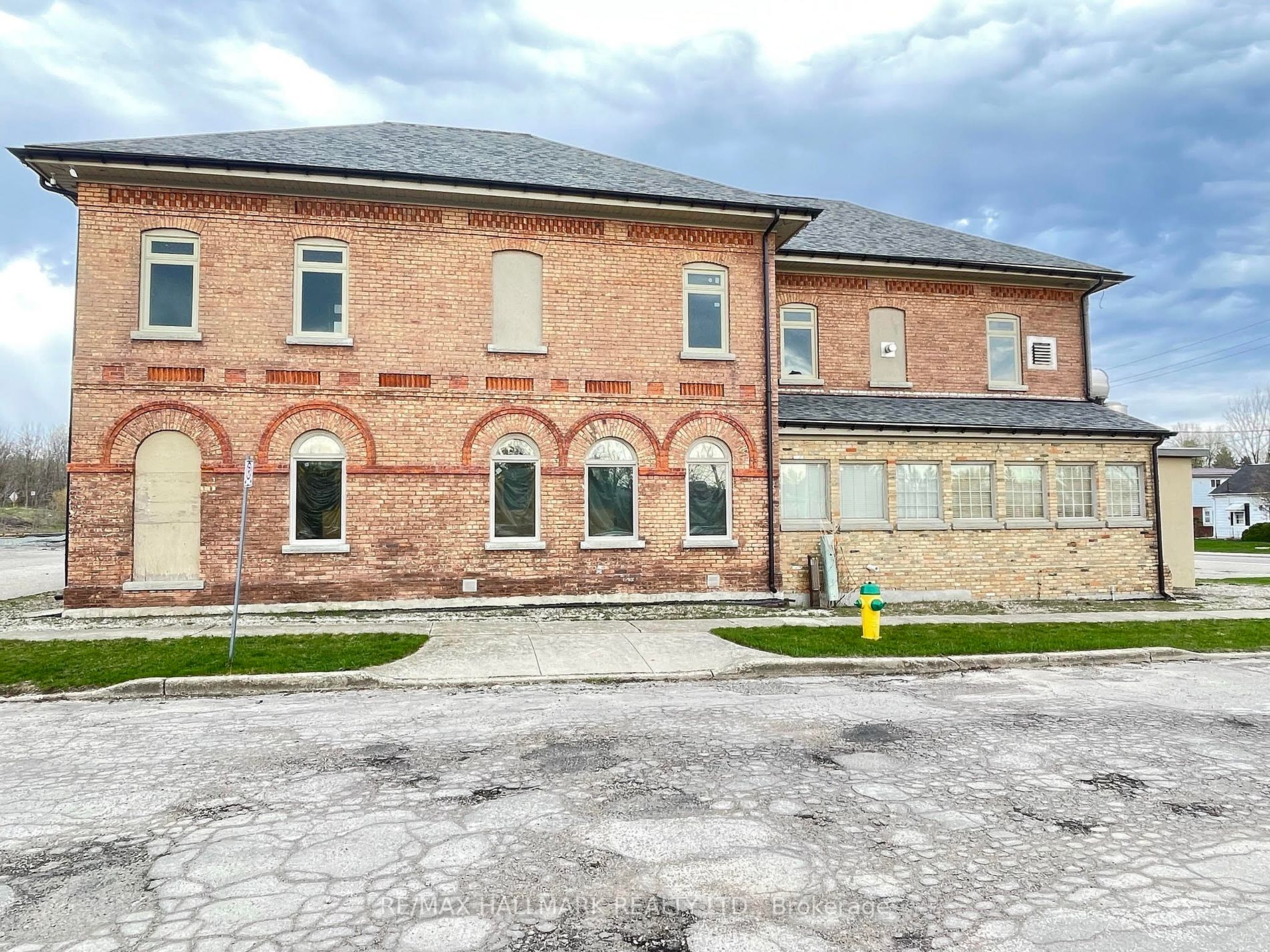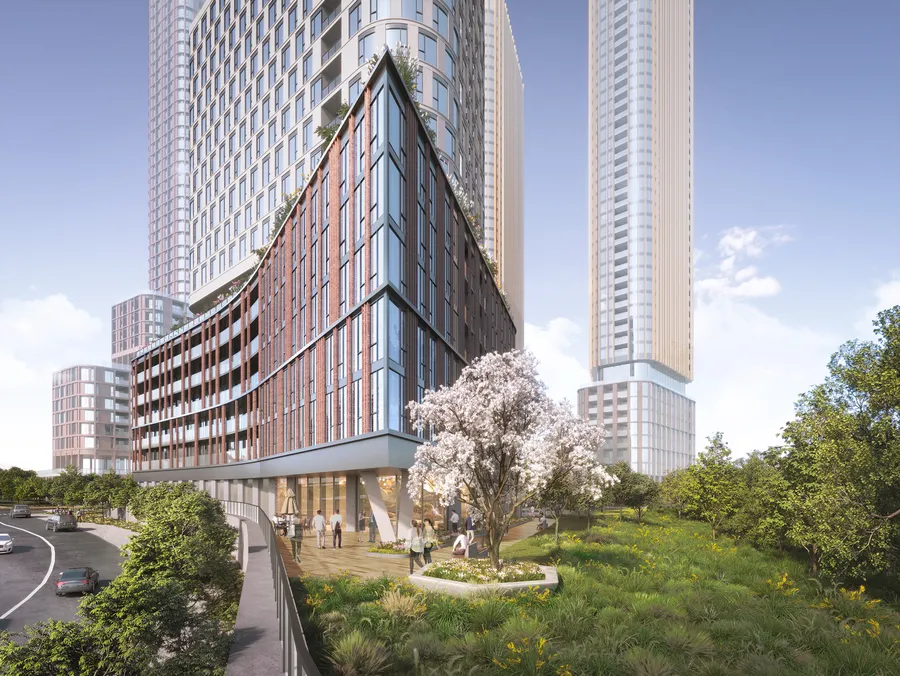
A proposed mixed-use development in Toronto, currently the site of a flourishing car dealership, may be a harbinger of the city’s postcar future.
The project at 1075 Leslie St., near Eglinton Avenue East, features five towers, ranging from 13 to 49 storeys, with 1,846 housing units and commercial and retail space wrapped around a green, pedestrian-oriented public courtyard.
It’s still early days for the 278,000-square-foot site; a community meeting is being held on Feb. 15 and the developers expect it will be years before city planning and zoning officials finish going through the details. But the ideas for the plan are significant – the development would alter the property’s past and present dependency on cars.

Some managers are trying to lure people back to the office with quality amenities
In Toronto’s Junction neighbourhood, the local outpost of co-working operator Spaces occupies part of a former warehouse. With a bright, airy design, wooden wall accents and minimalist furniture, it offers desk space, private offices and meeting rooms to companies that need to provide employees flexible work options.
Spaces The Junction is one of roughly 150 co-working locations across Canada owned by global giant IWG Plc. With its Spaces and Regus brands, Swiss-based IWG has the largest network of co-working spaces in the country — with clients that include some of the world’s biggest tech companies — but it’s still scrambling to keep up with demand.
Talking Points
- Demand for flexible office space is on the rise, and a new type of tenant-owner dynamic is emerging from this change
- Managers are more likely to prefer going back to the office than employees, so they are using quality amenities to lure workers back into the office
“Right now, we are in the middle of the storm,” said Wayne Berger, IWG’s chief executive for North America and Latin America. “We’re in the middle of the single largest … structural shift in commercial real estate and in how, when, where and what people call work.”
It’s been nearly a year since most provinces lifted COVID-19 restrictions and five months since the federal government removed all pandemic-related travel rules. As the Canadian workforce slowly returns to the office, companies are increasingly looking for space suitable for hybrid work. According to a new report from the commercial real estate firm Colliers Canada, released Jan. 24, demand for flexible office space will account for eight per cent of the total office demand, compared to six per cent predicted at the end of 2021. The real estate sector is now changing the way it works with tenants to cater to their changing needs.
The gap between where managers and employees want to work is contributing to the growing demand for flexible work spaces. “Businesses want their employees back in the office, certainly more than they are now,” said John Duda, president of real estate management services at Colliers Canada.
Nearly two in five managers prefer to be fully in-office compared to just one-fifth of employees, according to the report. Thirteen per cent of employees prefer fully remote work compared to just four per cent of those in management.
Berger thinks there are two reasons for the gap: one, many companies are still locked into leases they signed before the pandemic, and two, that current leadership climbed the corporate ladder in a different era. “They started their careers when … it was required for you to come to an office every single day. So, there is a romantic notion around mentorship, team building and culture that has to be done physically,” he said. “This idea of going to an office physically every day will frankly become a waste of money, and non-purposeful as generations continue to shift.”
In 2019, IWG fielded 30,000 inquiries about flexible office space in Canada, a record for the company at the time. In 2022 it had over 40,000 inquiries. In response, IWG started planning to increase its Canadian footprint, said Berger. The company aims to increase its number of locations to 250 and will open nine new locations in eight cities in the first half of 2023. As well as catering to small- and medium-sized businesses, IWG manages flexible workspace memberships for companies like Meta Platforms Inc., Amazon.com Inc. and Deloitte.
With companies moving towards flexible work arrangements, office-vacancy rates in Canada rose from 11 per cent at the end of 2020 to 13 per cent by the end of 2022. IWG took advantage of this trend to fuel growth by partnering with building owners. The owners put up capital to invest in a space and pay IWG a management fee to operate it. Over the past year, 90 per cent of new locations came from partnerships, compared to five per cent pre-pandemic, said Berger. Under this model, Berger claimed property owners won’t have to worry about vacant space and have a higher return rate than traditional leases.
“We cannot keep up with the demand that continues to surge for flexspace,” said Berger. “So we see that as an absolutely perfect opportunity.”
We’re in the middle of the single largest structural shift in commercial real estate and in how, when, where and what people call work
WAYNE BERGER, CHIEF EXECUTIVE FOR NORTH AMERICA, IWG
While the long-term impact on commercial real estate is still playing out, there’s already been a shift in discussions between landlords and tenants, said Duda. One notable change has been in the number and nature of additional features landlords are offering tenants. There is a high demand for quality amenities from companies wanting to lure employees back into the office, said Duda.
“That really is a new dynamic, it’s interesting, and it helps to shape what choices are being made at the asset level. … It’s more tailored to what people are looking for,” he said.
Property management companies have engagement programs to make sure they’re meeting a tenant’s specific needs. These include making it easier for employees to get into a building, such as by guaranteeing parking; and building social elements into offices, such as creating more space for meetings and daycares. IWG offers wellness packages to the employees of some of their corporate clients.
Source Financial Post. Click here to read a full story
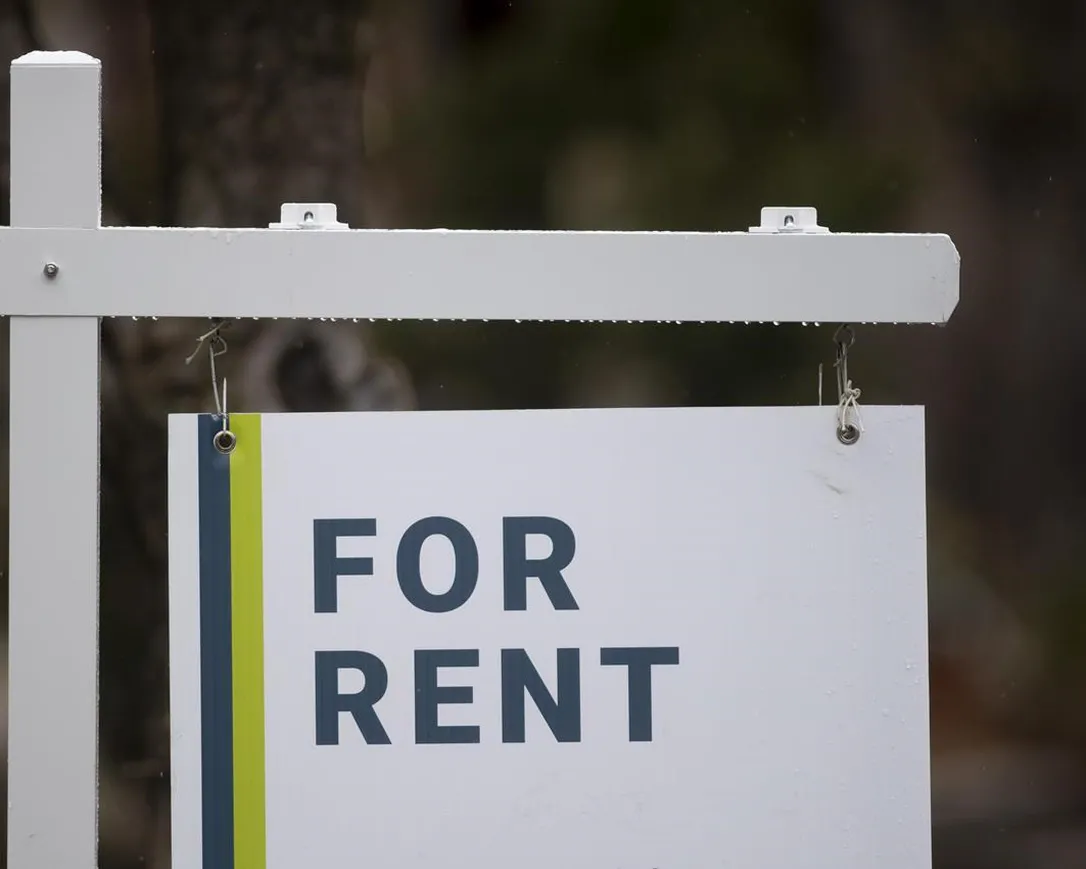
The report from Rentals.ca and Urbanation calculated the average listed rent to be $1,996 in January, down 0.5 per cent from December.
When compared with the pre-pandemic average rent in January 2020 of $1,823, rents in Canada increased 9.5 per cent, which amounts to an average annual increase of 3.2 per cent during the three-year period.
Shaun Hildebrand, Urbanation’s president, says the numbers indicate that Canada’s rental market started 2023 in line with the end of 2022 but saw sharp annual rent growth, low supply and quickly rising demand.
Vancouver and Calgary had the highest increases in average rent for condos and apartments in January, with annual growth of 22.9 per cent and 22.7 per cent, respectively.
Meanwhile, Toronto condo and apartment rents increased 20.8 per cent annually in January.
This report by The Canadian Press was first published Feb. 15, 2023.
Source The Star. Click here to read a full story
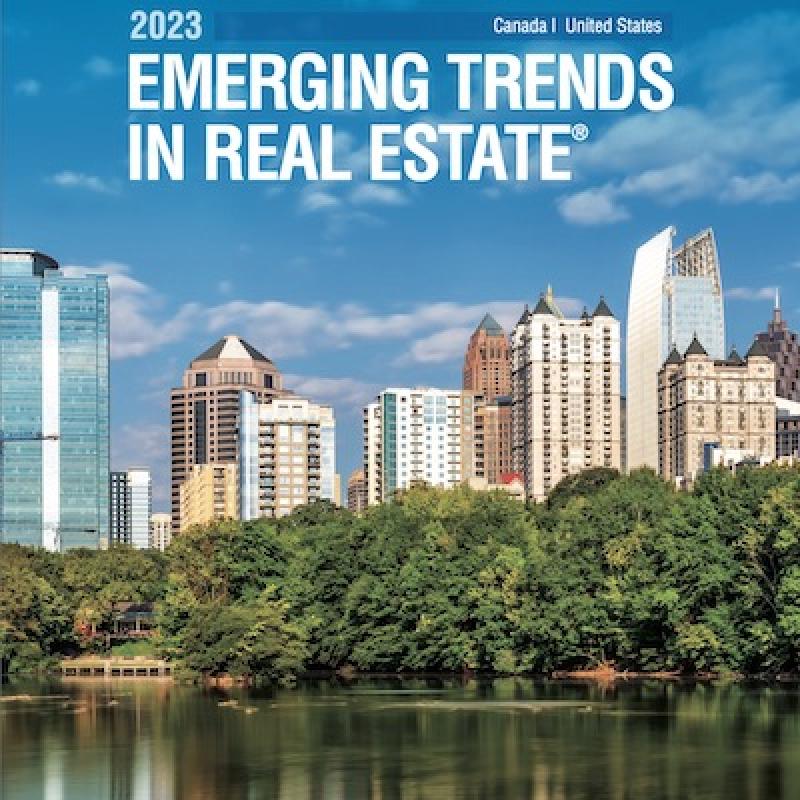
The commercial real estate landscape changed significantly in 2022, so it’s not surprising executives have a whole new set of problems to worry about, according to the ULI/PwC Emerging Trends in Real Estate 2023 report.
“Unsurprisingly, if we look at our predictions for 2022, things have changed a lot,” David Neale, assurance partner for PwC Vancouver, told a gathering of the Urban Land Institute as the report was unveiled in the Western Canadian city. “We’ve had a year of political uncertainty, the highest inflation since the 1980s and an overall tougher climate to operate in.
“Interestingly, when we asked people what’s keeping them up at night, the answers were pretty much identical between Canada and the United States. Most of these interviews and the data contained took place in the summer and fall, and sentiment is likely more bearish now than it was even six months ago.”
Held at the venerable Terminal City Club, the Feb. 7 event was the first in-person gathering for the ULI’s Vancouver chapter since COVID restrictions were put in place in 2020.
The gathering coincided with the public release of the Emerging Trends report. Jointly produced by the ULI and PwC, the annual report provides an outlook on real estate investment and development trends throughout the United States and Canada.
Interviewees and survey participants represent a wide range of industry experts, including investors, fund managers, developers, property companies, lenders, brokers, advisers and consultants.
ULI and PwC staff personally interviewed 617 individuals and survey responses were received from more than 1,450 individuals.
The highly regarded report is now in its 44th year.
The key concerns for CRE executives
In expanding on the findings, Neale noted: “Price discovery remains a key issue, with buyers, sellers and the lending markets hitting the pause button since the middle of last year.
“In 2022, there was an oversupply of capital. One year later, some respondents see an undersupply.”
The report also notes “sellers and buyers find themselves at odds over pricing expectations and valuations as some real estate assets come under pressure. Respondents identified interest rates and costs of capital as the top economic issue for real estate in 2023 and . . . both equity capital and debt capital are undersupplied.”
No. 2 on PwC’s list are impacts arising from ESG (Environmental, Social and Governance) factors which, Neale admits, “used to get huge eye rolls, but are now a concern since investors, lenders and private equity all need to report their own ESG numbers, and this results in a capital constraint.”
The report notes the Canadian real estate industry is a laggard when it comes to climate change strategy.
“In other areas of the world, investors are increasingly looking beyond whether a company has an ESG strategy to ask about plans to reach net-zero greenhouse gas emissions. And if a company does not have a net-zero strategy, they won’t invest.
“But while Canadian real estate players can expect to start seeing similar requirements from their own investors, our interviews showed that some companies have yet to fully embrace the net-zero imperative.
“According to PwC’s 2022 global CEO survey, just 19 per cent of real estate executives said that their organization had made a commitment to net-zero greenhouse gas emissions.”
ESG a key concern for millennial workers
One noteworthy aspect of the ESG conversation is its popularity with millennial workers.
“There’s still a war for talent and labour shortages in many professions,” Neale said. “Younger employees are communicating that they want to work with companies whose values line up with their own.”
Finally, conversations around housing affordability remain a key concern not just in the real estate industry, but throughout Canadian society generally.
“We’re told that we might get towards housing affordability if we build 5.8 million new homes by 2030. Well, right now we’re on track to build 2.3 million homes — roughly 300,000 housing starts per year — and that’s actually pretty good,” Neale said.
Add in high interest rates and the cost of owning a home gets even more prohibitive for many would-be homeowners, which in turn drives up apartment rental rates as well.
This is one reason why some people are exiting larger urban centres, but uncertainty over return-to-office requirements remains a factor for many.
“Canadians have been chasing affordability to smaller towns and cities, but we’re not quite sure how the work-from-home trend will end.”
Neale also offered a brief overview of the four main commercial and residential real estate sectors.
“The industrial category is a very safe sector, valuations are good, vacancies are low,” he observed.
“Office space and retail leasing will be unpredictable until we see how many workers return to the office.
“For instance, the Government of Canada controls 42 million square feet of office space and is facing resistance from workers, who want to continue to work from home.
“If even 20 per cent of this space was to hit the market, that would create a huge opportunity.”
Strong growth in 2023 for Vancouver
Specific to Vancouver, the report notes the city “continues to be (Canada’s) top market to watch for both its investment and development prospects,
The Conference Board of Canada is predicting healthy economic growth of 3.3 per cent in 2023.
“Rental demand is strong, while CMHC’s 2022 spring housing market outlook suggests that construction activity will not be enough to increase vacancy rates or reduce rents.
“And amid rising interest rates and slowing migration from other provinces, housing starts are declined by 15.8 per cent in 2022. The Conference Board predicts a further decline in housing starts of 6.4 per cent next year.
“The office market is seeing declining vacancy and climbing rents with new developments in the works; the majority of which are already pre-leased.
“The all-class downtown vacancy rate dropped to 7.2 per cent in the second quarter of 2022, down from 7.7 per cent at the start of the year, according to CBRE.
“Among the factors buoying the office market are a vibrant technology sector as well as a higher propensity for employees to return to the workplace in Vancouver and other cities in Western Canada.”
Vancouver’s industrial vacancy rate of 0.1 per cent is the lowest in Canada, while a Colliers report noted a 22.5 per cent year-over-year rise in the asking net rent.
The ULI/PwC report states while “some interviewees are watching for signs of a slowdown in Vancouver’s industrial market and the impacts of rising interest rates, others emphasize that land scarcity makes this asset class a best bet.”
Source Renx.ca. Click here to read a full story

The roller-coaster ride continues for the MSCI/Real Property Association of Canada (REALPAC) Canadian Property Index. After plunging due to COVID-19 in 2020 and making a solid recovery in 2021, the 2022 results showed only a small overall return.
“We had the 2020 depths, a rebound in ’21, but then another drop in ’22 because the other shoe to drop was interest rates going up,” REALPAC chief executive officer Michael Brooks told RENX.
The total return on all assets, including developments, was 2.33 per cent in 2022. That compares to 7.9 per cent in 2021 and negative 4.1 per cent in 2020.
The total return on standing assets, which covers existing buildings, was 1.35 per cent. That figure was arrived at via a 4.35-per cent income return and capital growth of negative 2.9 per cent.
To put that in context, Brooks said the Toronto Stock Exchange (TSX) Composite Index was down 8.7 per cent, the S&P/TSX Capped REIT Index was down 20.5 per cent and the Total REIT Index was down 17 per cent in 2022.
What the MSCI/REALPAC Property Index measures
The MSCI/REALPAC Canadian Property Index measures unlevered total returns of directly held property investments.
Its goal is to enhance transparency, enable comparisons of real estate relative to other asset classes and facilitate comparisons of Canadian real estate performance to other private real estate markets globally.
The index started in 1985. It includes buying, selling, development and redevelopment activity data provided by major pension funds, insurance companies and large real estate owners in Canada.
The 2022 index encompassed 48 portfolios with 2,370 assets totalling 489.5 million square feet and a gross capital value of $172.8 billion.
The index has averaged an annual total return of 8.5 per cent since inception and 5.7 per cent over the past 10 years.
All asset classes trended downwards
All asset classes trended downwards in 2022. While industrial had a total return of 17.1 per cent, it was 31.6 per cent in 2021. The 2022 residential total return was 4.8 per cent, followed by retail at negative 3.9 per cent and office at negative 5.8 per cent.
Industrial capital growth was 13.1 per cent, followed by residential at 1.5 per cent, retail at negative 8.4 per cent and office at negative 10.2 per cent.
Office and retail returns were negative in most of the eight major Canadian cities included in the index.
The downtown office return was negative six per cent, compared to negative 6.2 per cent for suburban office. The corresponding 2021 return numbers were 2.4 per cent for downtown office and 4.3 per cent for suburban office.
Halifax had an 8.3 per cent total return, followed by Edmonton at 2.4 per cent, Montreal at 1.9 per cent, Calgary at 1.5 per cent, Vancouver at 1.1 per cent, Toronto at 0.7 per cent, Ottawa at negative two per cent and Winnipeg at negative 4.1 per cent.
Capital growth was negative in every city except Halifax, where it was 2.5 per cent. It was negative 2.1 per cent in Montreal, negative 2.8 per cent in Vancouver, negative 2.9 per cent in Edmonton, negative 3.1 per cent in Toronto, negative 4.6 per cent in Calgary, negative 6.1 per cent in Ottawa and negative 9.2 per cent in Winnipeg.
Brooks believes Halifax was the top performer because it has plenty of multiresidential, which performed relatively well, in its portfolio. He’s unsure why Winnipeg trailed the other seven cities in both total return and capital growth.
The U.S. had a total return of 5.7 per cent in 2022, which was about 2.5 times higher than Canada.
Brooks said the U.S. MSCI Property Index is heavily weighted towards multiresidential and doesn’t include much office, so it’s “difficult to make a true apples-to-apples comparison” of the performances of the two neighbouring countries.
2023 forecast
Brooks said it’s difficult to predict where the 2023 MSCI/REALPAC Canadian Property Index results will end up as it remains to be seen where interest and inflation rates will go.
“These macro issues are going to bear on the potential returns. If there’s a recession, do we have some more business failures in office?
“Do we have more tenants reducing their footprints in office buildings and that cutting into office rent revenues? There is still a lot of uncertainty.”
Brooks said Q4 2022 was the second during which there were property valuation write-downs and he wouldn’t be surprised if there are more this year.
“I attribute that to the fact that the valuers will have more transactional data to rely on and there will be more comparables,” he said. “All it will take is one distress sale to set a benchmark and pull values down a bit more.
“So we’ll see how we fare in Q1 in terms of capital growth, but the income return should continue to be there for all of the asset classes as their tenants are still in there paying rent so far.
“I’ve heard of no material defaults, although we’re certainly watching a few retailers like Bed Bath & Beyond, which is apparently struggling a bit, and there may be a few others that had too much debt — particularly if it’s floating rate debt.”
MSCI and REALPAC
MSCI provides decision-support tools and services for the global investment community. It has more than 50 years of expertise in research, data and technology to power better investment decisions by enabling clients to understand and analyze key drivers of risk and return when building portfolios.
REALPAC was founded in 1970 and is the national leadership association dedicated to advancing the long-term vitality of Canada’s real property sector.
Its 130-plus member companies include publicly traded real estate companies, real estate investment trusts, pension funds, private companies, fund managers, asset managers, developers, government real estate agencies, lenders, banks, life insurance companies, investment dealers, brokerages, consultants, data providers, large general contractors and international members.
REALPAC members have $1 trillion in assets under management and represent office, retail, industrial, apartment, hotel and seniors residential properties across Canada.
Source Renx.ca. Click here to read a full story
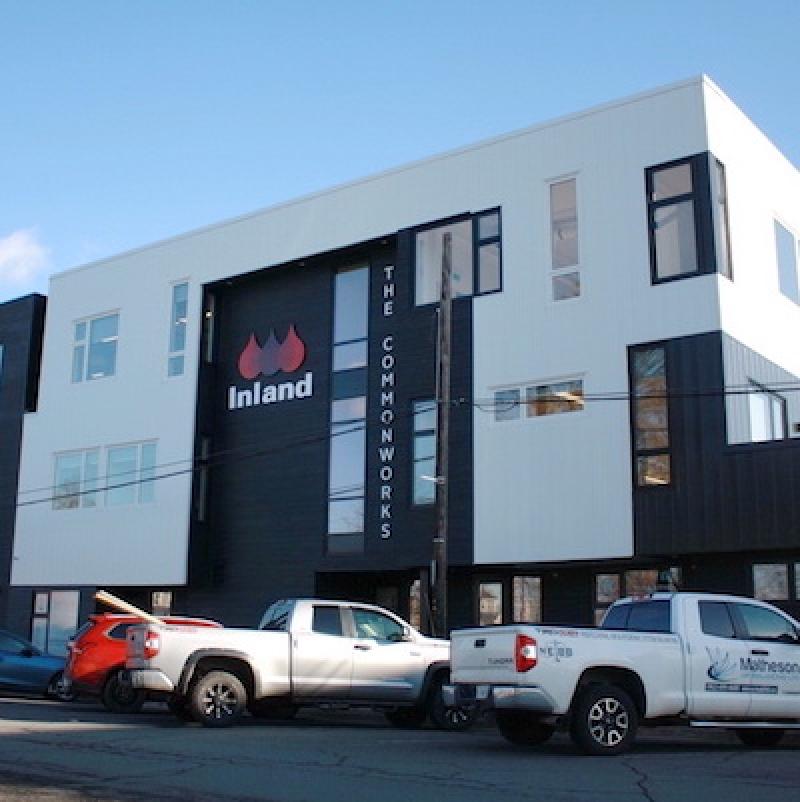
Flexible workspace and office provider IWG had a successful 2022 and will open nine new Canadian sites in the first part of this year as it looks to grow by 100 locations – to 250 sites – during the next three years.
IWG experienced major growth in Canada from 2014 to 2019, but offices in the country reopened more slowly from COVID-19 restrictions than in some other territories.
IWG Americas chief executive officer Wayne Berger told RENX that — while recovering more slowly in Toronto, Montreal and Ottawa — the overall business rebounded so well last year demand for flexible workspace has increased by about 30 per cent from pre-pandemic levels.
IWG opened nine Canadian sites in 2022 and is focusing on expansion in secondary, tertiary and suburban markets in which it had no, or minimal, presence.
“People are working in a more geographically disparate way than ever before and only coming into a company’s corporate headquarters when it’s necessary,” said Berger. “So the accelerated demand that we’re seeing is due to the changing nature of how people are able to live and work differently today.
“People are able to live in cities like Cambridge, Truro and Saskatoon and work for companies based in Toronto and Vancouver.”
Alternative for companies reducing real estate
The company, which is headquartered in Switzerland, works with 83 per cent of Fortune 500 companies, many of which are rationalizing their real estate portfolios.
It doesn’t make sense, according to Berger, for some of these firms to lock into a 10-year lease for a single large office footprint and spend millions of dollars on renting, furnishing and managing it.
“They’re now giving their team members access to 20, 30 or 50 locations that make sense for them,” Berger said.
“That ability to be untethered from one location and use technology to work from whatever physical location they need to has become a real game-changer for these companies.
“It’s shifting how people in companies are using space.”
IWG has approximately 3,500 locations in 120 countries, with 1,000 new centres due to be added over the next year.
It’s aiming to attract a variety of landlords — including real estate investment trusts, investors, property management companies, banks and asset managers — as part of its ambitious growth plans.
Berger said 90 per cent of the new sites IWG is launching for its flexible workspace brands — including Regus, Spaces, HQ, No18, Signature and The Wing — are in partnership with building owners and institutional developers.
When deciding what brand to open in a particular location, Berger said it looks at factors including: the type of building and size of space; the market and what IWG already offers there; the local competition; the capital investment the building owner is willing to put into the space; and the price point that would be the best driver for success.
Canada’s first four HQ locations
IWG will open its first four HQ locations in Canada this year:
- Queens Realty Limited is the landlord partner in the 7,500-square-foot HQ Truro facility at The Common Works complex at 1 Commercial St. in the Nova Scotia town. It’s set to open in February.
- Huntington Properties is the landlord partner in the 7,200-square-foot HQ Ottawa location at 396 Cooper St. that’s set to open in March.
- Multivesco is the landlord partner in the 5,000-square-foot HQ Gatineau location at 200 Montcalm St., Tower 1 in the city across the Ottawa River from the nation’s capital. It’s set to open in March.
- ELM Developments is the landlord partner in the 19,800-square-foot HQ South Edmonton location set to open in the ELM Business Park at 9426 51st Ave. in May.
“HQ is a brand that has a lower cost to build, but it’s very beautiful, very productive and provides all the design aesthetics and amenities that a company would want for its clients and for its team members,” said Berger.
“I think HQ has a tremendous brand equity and a significant amount of growth opportunity in Canada.”
Other IWG locations opening in Canada this year
Here are the other IWG locations confirmed to open in Canada in the next six months:
- Markland Property Management is the landlord partner in the 17,266-square-foot Regus Cambridge at 73 Water St. in the Southwestern Ontario city. It’s set to open in February.
- IMC Management is the landlord partner in the 10,600-square-foot Regus Sherbrooke location at 455 King St. W. in the Eastern Quebec city. It’s set to open in April.
- Deerfoot Atria Partners Ltd. is the landlord partner in the 15,000-square-foot Regus Calgary location at 6815 8th St. N.E. Calgary’s 15th Regus site is set to open in June.
- Memnon Management Inc. is the landlord partner in the 22,077-square-foot Spaces Leslieville location in The Wrigley Building at 235 Carlaw Ave. Toronto’s 14th Spaces site is set to open in May.
- Lighthouse Hospitality Management is the landlord partner in the 17,000-square-foot Spaces Edmonton in the 28-storey Peak Tower (formerly Enbridge Tower) at 10054 102 St. It’s set to open in July.
Berger said IWG is also in negotiations with building owners to open its first upscale Signature locations in Toronto, Montreal, Vancouver and Ottawa.
Source Renx.ca. Click here to read a full story
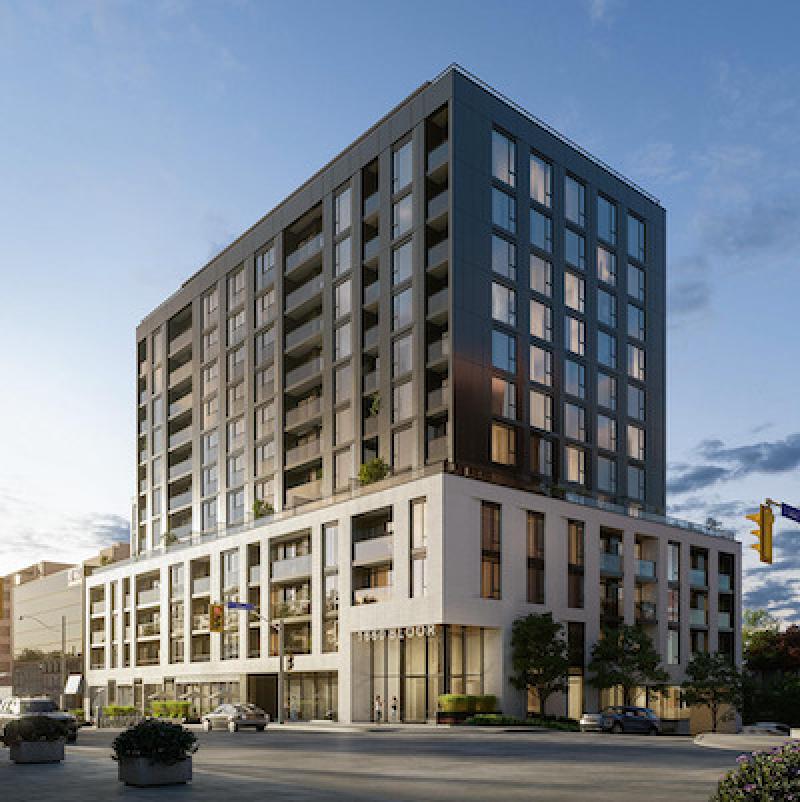
Mattamy Homes’ Greater Toronto Area (GTA) Urban Division officially broke ground on three condominium developments in late January: Westbend on Bloor Street West in Toronto; Mile & Creek in Milton; and Martha James in Burlington.
It’s a reflection of Mattamy’s belief there’s still demand for new condos despite slowing sales over the past several months said Alison O’Neill, vice-president of sales, marketing and design studio for Mattamy’s GTA Urban Division.
“I think people have been a little bit gun-shy on actually pulling the trigger on a purchase,” she told RENX. “I think everyone’s waiting for the mortgage rate announcements to settle down and waiting to see what’s happening with pricing. And I think we’re hopefully coming around the other side of that.”
O’Neill said Mattamy offered a more attractive deposit structure to purchasers for its two most recent launches than it may have during times when units were moving faster, and it seemed to help.
Launching three projects simultaneously, at a time when construction projects have experienced rising costs and delays due to labour and materials shortages, may seem risky. However, O’Neill said these possibilities have been factored into their scheduling and budgeting.
Westbend
The 13-storey, 174-unit Westbend is at 1660 Bloor St. W., between the Keele and Dundas West subway stations and northeast of High Park.
Unit sizes will range from studios of 425 square feet up to approximately 1,100-square-foot three-bedroom suites. Prices started in the low $600,000s and about 70 per cent of the units have been sold since the November launch.
Amenities at the BDP Quadrangle-designed building will include a co-working space, a fitness centre, a meditation deck and a rooftop lounge.
Work on a geothermal heating and cooling system is to begin soon, and occupancy is scheduled for July 2025.
Mile & Creek
The first phase of the six-building master-planned Mile & Creek condo community is at 760 Whitlock Ave. in Milton. It backs on to protected green space a short drive from Hwys. 401 and 407 and the Milton GO Transit station.
Sales launched in November for the first two eight-storey buildings, which will have a combined 226 units ranging in size from 500-square-foot studios up to three-bedroom-plus-den suites of more than 1,000 square feet. Prices started in the mid-$500,000s.
The next two phases will also feature two eight-storey condos, with sales for the second phase expected to launch late this spring.
Mile & Creek will feature a three-storey amenity pavilion featuring a fitness centre, a media room, co-working space and a rooftop lounge and barbecue area that will be shared by all six buildings.
Work has begun on the geothermal heating and cooling system and the first phase is expected to be occupied in September 2024.
Martha James
Units at the 13-storey, 150-unit, Graziani + Corazza Architects-designed Martha James, located close to downtown Burlington and the shore of Lake Ontario at the intersection of Martha and James streets, went on sale last February.
Prices for the launch were around $1,100 per square foot and the building is essentially sold-out.
Units range in size from about 500 to around 1,000 square feet. Martha James will feature a ground-floor fitness centre and an outdoor terrace, co-working space and lounge on the top floor.
Occupancy is slated for April 2025.
Soleil and ClockWork
Mattamy’s GTA Urban Division previously launched two other condo projects that will be completed before Westbend, Mile & Creek and Martha James.
Three of the four six-storey buildings at Soleil Condos in Milton are sold out and only a few units remain in the fourth. Occupancy for the first two buildings will take place this summer, while the last two should be occupied before the end of the year.
The second of two buildings at ClockWork Condos at Joshua Creek in Oakville went on sale last April and its units are 80 per cent sold. The two buildings in the mixed-use community, which also includes a retail element, are under construction.
ClockWork also features geothermal heating and cooling.
Occupancy is scheduled for the autumn of 2024.
Other major projects on the way
Mattamy is North America’s largest privately owned homebuilder, with more than 40 years of experience in Canada and the United States.
Its GTA Urban Division has 40 high-rise and multiresidential developments within its master-planned communities and its pipeline has grown to more than 13,700 suites across 19 communities.
“The recent success we’ve had on our sales launches really reaffirms our commitment to the market as well as to the multifamily market,” said O’Neill.
Mattamy’s GTA Urban Division has three other major near-term developments in the works.
It has been chosen as QuadReal’s partner for the first phase of the redevelopment of the Cloverdale Mall site in Etobicoke.
Mattamy acquired an ownership stake in the stand-alone 2.3-acre “Triangle Site” adjacent to the mall.
The partners will jointly develop a project that includes condos of 32 and eight storeys, a connecting podium structure and about 2,400 square feet of retail space. It will offer more than 500 units and sales should launch late this year or early in 2024.
Mattamy will oversee development, construction, sales and marketing for the Triangle Site while QuadReal will retain overall strategic direction of the district master plan for the 32-acre property.
It will also maintain long-term ownership of the mixed-use community’s retail and purpose-built rental components.
Mattamy acquired a Scarborough site called The Mile at 1891 Eglinton Ave. E. It’s going through the approvals process but the plan is to build five or six condo towers with a combined total of close to 2,000 units.
There are also plans to launch sales for a 50-storey condo with more than 500 units at 85 St. Nicholas St., just west of Yonge Street and south of Bloor Street West in Toronto, late this year or early next year.
That project is working its way through the site plan approval process.
Source Renx.ca. Click here to read a full story
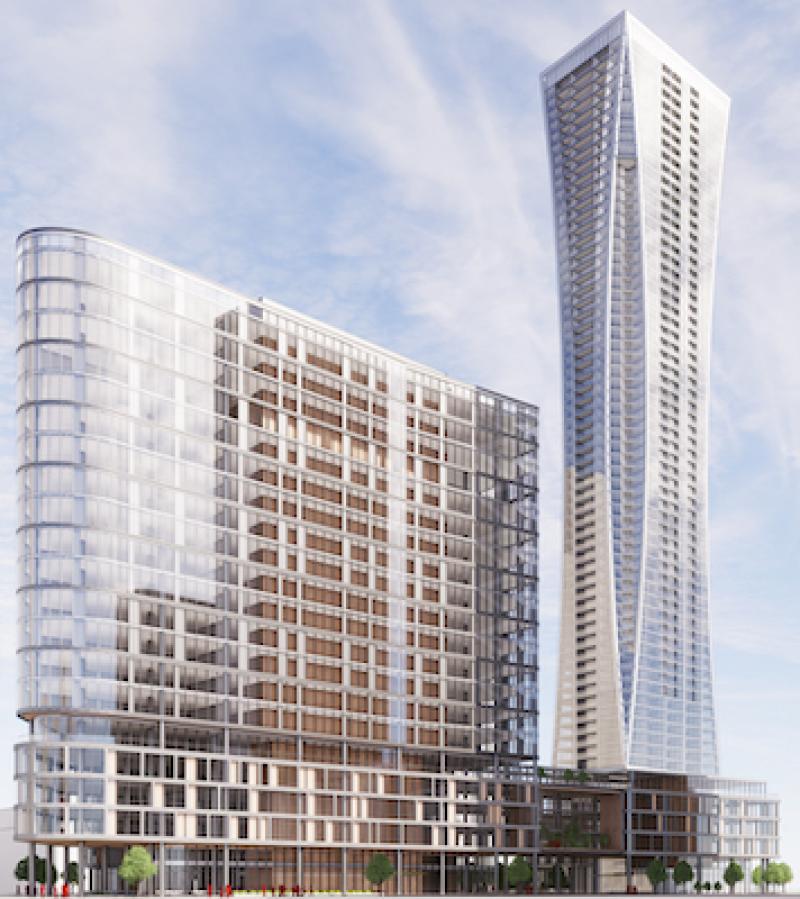
SmartCentres REIT had a very solid 2022 and expects that positive momentum to continue this year, executives revealed during a Feb. 9 conference call to discuss its Q4 and year-end financial and operating results.
“From virtually every perspective, 2022 was a strong recovery and 2023 is shaping up to be more of the same,” said Rudy Gobin, executive vice-president of portfolio management and investments. “Physical retail and especially our value-oriented and enclosed centres continue to be in high demand in communities across Canada.”
SmartCentres’ (SRU-UN-T) portfolio is comprised of 185 properties comprising 3,500 acres and 34.8 million square feet of income-producing retail and office space. Walmart anchors about three-quarters of the retail properties.
“The fourth quarter capped off a year of resurgence both in consumer traffic and retailers wanting more space,” said executive chairman and chief executive officer Mitchell Goldhar.
“Not only are we seeing continued demand for space in most of our nearly 35-million-square-foot value-oriented portfolio, but we are also welcoming new retailers to our centres in many segments, allowing us to provide a more compelling and diverse offering to every community we serve across Canada.”
Operational highlights
Shopping centre leasing activity remained strong with occupancy at 98 per cent in the fourth quarter ended Dec. 31. That represents a 40-basis point increase from 2021 and a return to pre-pandemic levels.
SmartCentres completed 720,000 square feet of vacancy leasing in 2022. Leasing demand was driven by a variety of tenants, including grocery stores, dollar stores, pharmacies and health and beauty retailers. In non-urban markets, demand has also come from furniture, home decor, appliance and craft stores.
The REIT renewed almost 90 per cent of maturing leases comprising about 4.5 million square feet, with an average rent increase of 3.1 per cent. It has already renewed half of the leases maturing this year.
Financial results
“The financial results for the fourth quarter reflected continued solid performance in our core business, with results that are now trending above pre-COVID levels by virtually every measure, including net operating income, payout ratio and average rent per square foot,” said chief financial officer Peter Slan.
Same property net operating income for the quarter increased by $5.1 million, or four per cent, as compared to Q4 2021. It rose by $16.5 million, or 3.3 per cent, for the full year.
SmartCentres’ total assets were $12.1 billion at the end of the year, compared to $11.5 billion to close 2021. It has an unencumbered pool of assets valued at $8.4 billion, a 43.6 per cent debt-to-asset ratio and significant liquidity, according to Goldhar.
“We remain comfortable with our conservatively structured debt ladder where the most significant aggregate maturities are in 2025 and 2027,” said Slan.
“We do have an upcoming maturity this spring with a $200-million debenture and we are currently exploring multiple refinancing options.
“Approximately 82 per cent of our debt is at a fixed interest rate, which has been a significant benefit to us during the recent rising rate environment. In short, our balance sheet remains strong.
“It withstood the pandemic well and we believe that we are extremely well-positioned to fund the various growth-oriented development projects that are currently in our pipeline.”
Development activity
SmartCentres’ intensification program consists of rental apartments, condos, seniors’ residences and hotels that will be developed under the SmartLiving banner, and retail, office and storage facilities that will be developed under the SmartCentres banner.
It’s expected to produce an additional 56.1 million square feet (with 41.2 million square feet being SmartCentres’ share) of space.
SmartCentres achieved more than 6.1 million square feet of permissions for new mixed-use developments in urban locations with high demand for housing in 2022.
More than three million square feet of construction activity is underway, principally high-rise condominium and purpose-built rental residential on existing shopping centre sites in and around Toronto, Montreal and Ottawa.
All of these projects are expected to be completed by the third quarter of next year.
“The REIT’s share of the total expected project costs, including land, is $539 million, of which $304 million has been spent to date,” said Slan.
“We have more than adequate liquidity to finance the remaining $235 million of construction costs associated with these projects.”
Current developments
Construction of the 45- and 50-storey Transit City 4 and 5 condo towers at the SmartVMC site in Vaughan is in the final stages, with closings scheduled to start in March. All 1,026 units have been pre-sold and construction costs are on budget.
Construction of The Millway, a 36-storey, 458-unit purpose-built rental apartment building that’s also part of SmartVMC, will have its first tenants take occupancy this month.
The REIT’s share of SmartVMC, when completed, is expected to include approximately 20 million square feet of mixed-use space.
SmartCentres and its partners recently started construction of a townhome subdivision with 174 homes at the nearby Vaughan Northwest development.
Goldhar said apartments in the Montreal suburbs of Mascouche and Laval are nearing completion and have received a high level of interest from renters.
Construction of a 240,000-square-foot industrial building with 40-foot clear heights on 16 acres of a 38-acre site on Highway 407 in Pickering, Ont. is in the final stages and half of it has been pre-leased, according to Goldhar.
Construction continues on the 402-unit Laurentian Place retirement residence and seniors’ apartment project in Ottawa, with completion expected in the first quarter of 2024.
“Our JV partner on this project, Groupe Sélection, is currently facing some financial challenges,” said Goldhar.
“However, construction is continuing and SmartCentres continues to support this project and we are confident in a path to substantial and successful completion.”
Goldhar said the REIT has opened seven self-storage facilities in the Greater Toronto Area and has three more under construction — which will have more than 2,600 storage units — in Markham, Brampton and Whitby.
SmartStop Asset Management, LLC is a joint venture partner in SmartCentres’ self-storage properties.
“We are very pleased with the performance, both in terms of stabilization and overall NOI,” said Goldhar, noting SmartCentres’ yield for self-storage is exceeding seven per cent.
Future development
SmartCentres has 48 other development projects scheduled to start construction in the next two years, though some could be put on hold if it’s decided the timing isn’t right due to variables including higher interest rates and inflation, other economic factors or political uncertainty.
Goldhar said multiresidential developments are at the most risk of being held back because they’re the most capital-intensive and take the longest to build.
“However, sitting back is not in our DNA,” said Goldhar. “Over the past 30 years, we have consistently navigated and pushed forward in many market conditions, building a dynamic and resilient portfolio starting from 1994 with the opening of the first newly built Walmart in Canada.
“At SmartCentres, we’re far too forward-thinking to be distracted by noisy headlines to take our eye off our long-term vision and objectives of building lasting value for communities across Canada and enhancing value and growth for our unitholders.”
Source Renx.ca. Click here to read a full story
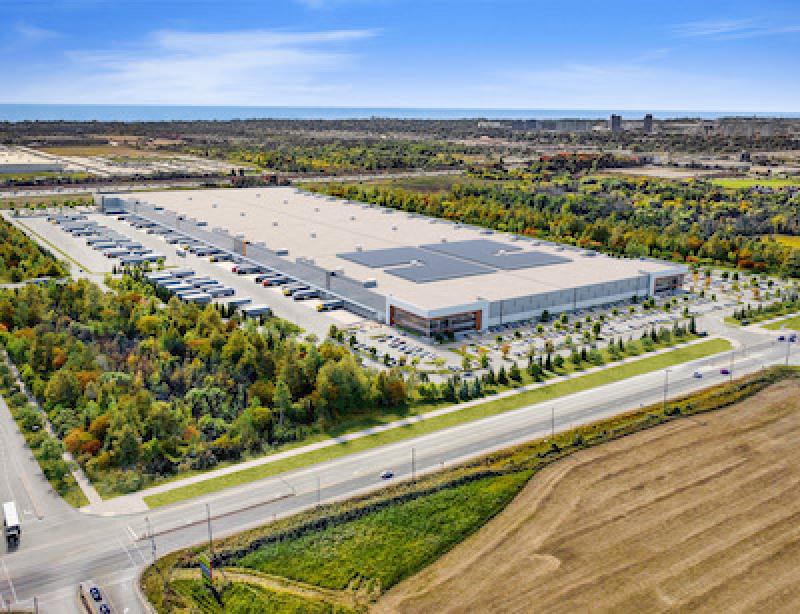
By any standard, the growth of Pure Industrial across Canada during 2022 was impressive. Shocking might be a better word.
The privately owned investor (the former Pure Industrial Real Estate Trust had been acquired by Blackstone and Ivanhoé Cambridge in 2018 and taken private in a $3.8-billion transaction) opened the year with a $312-million portfolio acquisition and closed it with a $400-million acquisition, both in the Greater Toronto Area.
In between those book-end transactions, it also absorbed the prodigious industrial component of the former Cominar REIT as part of a multi-billion-dollar joint venture transaction.
In effect, a portfolio which started the year at 150 properties exploded to over 415 spanning most of Canada, from Rimouski, Que., in the east to Metro Vancouver in the west and including virtually every major city in-between.
2022 “a great year” for Pure
“The growth in 2022 was enormous,” Pure’s chief operating officer David Owen told RENX in an interview. “We made the Cominar industrial portfolio acquisition, which came with 15 million square feet in the Province of Quebec.
“We hired 60-plus employees and we’ve added a bunch more. We have a comprehensive office in Montreal and Quebec City, and are able to extend our platform reach into that province which is really beneficial.
“From a growth perspective, people, properties and overall platform capability, it’s been a great year for us. The core focus of it being in Montreal, Toronto and to a lesser extent Vancouver.”
Pure’s portfolio now spans over 41 million square feet of space.
Having rapidly become one of Canada’s largest industrial property owners, Pure has carefully cultivated a portfolio which can serve all sizes and types of tenant, particularly in the light industrial and warehousing/distribution sectors.
The December GTA portfolio acquisition
Its latest acquisition involves a 1.5-million-square-foot portfolio in the Brampton, Mississauga and Western Greater Toronto Area.
Although he declined to provide specific details because of confidentiality requirements, Owen did say the portfolio provided Pure with a property class which is very tough to come by in the GTA.
“It’s actually primarily the quality of the portfolio, the unique aspects of it, where it’s located and the density within the portfolio,” he said when asked why it was of interest to Pure.
“We have a fairly significant presence in the Brampton, Mississauga, GTA West corridor, (but) these properties in particular feature low site coverage (and) excess trailer parking which we’ve seen extremely high demand for. Additionally, (there is) a lack of new buildings that are anything like it.”
He said most developers are currently building with maximum site coverage to earn higher development profits based on building square footages, so there are very few new properties available with extensive truck/trailer parking and storage.
Municipalities also are not granting as many approvals for these types of properties – especially in prime employment zones.
There is, however, demand for these facilities.
“We’ve seen the opposite take place from a tenant demand perspective – there is a lot of tenant demand in this specific build,” he explained. “I think that’s a function of a couple of things, one on-shoring, and having more local capacity as opposed to the just-in-time.
“Being able to store containers for excess demand is something a lot of our customers are starting to do locally. I think that is going to be a trend for the foreseeable future especially coming out of COVID and the disaster the supply chain went through and the inflation it caused as a result.
“The bottom line is the more land you have to store, whether it’s trailer or outside storage of goods . . . having that capability is, I would say, very unique in the GTA.”
Major developments for Ajax, Brampton, Hamilton
Unlike some industrial owners which want to focus on one class or type of facility, Pure wants to be involved in the entire spectrum.
“If you want to consolidate with us, let us know. We have large-bay facilities for you, we have small-bay facilities if you need last-mile and then we have your standard mid-bay, kind of a hub-and-spoke model,” he explained.
“We own a diverse set of buildings, small-, medium- and large-bay and within that thousands of units which are completely differentiated from one another. What we want to offer to our customers is really that experience, that model that they can come and talk to us for any size.”
That means continuing to expand both through future acquisitions and through development. On that front, among several major projects Pure has just brought to market is the 1.2-million-square-foot Lakeside Logistics Centre to be constructed along Kingston Road in Ajax, just east of Toronto.
Pure is at the approvals stage for the project, which if not the biggest, is certainly one of the biggest industrial buildings currently on planning boards in Canada.
Although some sectors of the economy might be slowing due to higher interest rates, inflation and other factors, Owen said the industrial metrics remain very strong.
“Look at all the new developments that went up and how quickly they keep being absorbed in the GTA. I keep seeing leased, leased, leased.
“I think that’s a function of the fact a lot of these businesses are making long-term decisions: ‘This is where I need to be, this is where I want to be and this is a class-A facility. Let’s take it now before we regret not taking it.’ ”
Especially in the GTA, there is still also demand for large state-of-the-art facilities. Most new product coming to market is pre-leased, which means it doesn’t impact the critically low sub-one per cent vacancy rate. Lakeridge is scheduled for delivery in Q4 2024.
“That’s probably going to be similar to Kingston Road. This is a state-of-the-art, 40-foot clear facility with excellent design . . . we are also going to try to make it as ESG-friendly as possible.”
Pure also has a couple of other major projects at various stages of development including a 630,000-square-foot, two-building site under construction in Brampton in partnership with Hopewell Development. That is slated for summer delivery, with buildings of 458,496 and 167,909 square feet, respectively.
Further out in the planning process is land adjacent to the Hamilton airport, known as Upper James Landing, which could accommodate over a million square feet of industrial development and 40-foot clear heights.
Currently in the planning stage, Pure is marketing several potential configurations for the site, including one-tenant and multi-tenant options.
Source Renx.ca. Click here to read a full story

Industrial availability is opening up in the tight Windsor market where a huge production facility for lithium-ion batteries and a coming resurgence in automotive production are combining to turn around the city’s fortunes.
CBRE’s office in the city, located just across the border from Detroit, is listing three million square feet. That’s leading some, including CBRE associate vice-president Brad Collins, to predict 2023 could be a record year for industrial transactions in Windsor fuelled by companies wanting to be affiliated with the electric vehicle (EV) battery plant.
Properties at 1000 Henry Ford Centre Dr. and 2935 Pillette Rd., totalling 1.7 million square feet, pushed the 1.4 per cent availability rate in the third quarter up to 4.93 per cent to end the year, according to CBRE. The fourth-quarter vacancy rate was 4.55 per cent.
Collins told RENX there were only four or five existing options for industrial users seeking 100,000 square feet or more so land sales and new construction will remain key going forward.
While Windsor experienced a 12.8 per cent year-over-year increase in average net industrial rent, closing 2022 at $9.27 per square foot, that’s still well below many manufacturing markets across Canada. Double-digit rental rate growth is anticipated for this year.
Low rents have attracted some Greater Toronto Area (GTA) manufacturers that were priced out of that market in recent years, which has benefited the Windsor economy.
“We’re really starting to see groups that historically would stick to the GTA on the investment side and the development side really start to flirt down here,” said Collins.
“We think that’s great from a market standpoint in terms of growing our market and improving the sophistication of some of these developments and types of products we have because a lot of our stock is older stock.
“We haven’t had this development boom historically, despite having availability rates near rock bottom.”
Electric vehicle battery plant a huge addition
Windsor was given a big boost last March with the announcement that Canada’s first lithium-ion EV battery plant — a joint venture between automaker Stellantis and battery-maker LG Energy Solution — would be built in the city.
Stellantis is already the largest private employer in the Windsor area and the $4.9-billion, 4.5-million-square-foot EV battery plant is expected to employ 2,500 and generate more economic activity in a region that had been hit hard by layoffs in the automotive industry.
“Investor confidence in Windsor assets really turned overnight, from a market that historically has been a bit of a boom-and-bust automotive-based, manufacturing-based economy,” said Collins. “There’s always been the threat of losing Stellantis as a major employer for our community.
“With this announcement, and some of the announcements that led up to it from an assembly plant standpoint, that really transformed how people view Windsor and the stability of it going forward.”
“You’ve now got a more diversified supply chain that’s going to be coming in here,” CBRE senior vice-president Brook Handysides told RENX. “Even though it’s aligned with automotive production and manufacturing, it’s basically a new branch off of that tree.
“So you’re dealing with battery production and all of that supply chain that will align as a complement to the automotive manufacturing backbone that’s already here.”
Construction has begun on the EV battery plant, which Collins said is to be operational in late 2024 or 2025.
CBRE is also marketing a 27.58-acre site with two industrial buildings, totalling 342,786 square feet at 9355 Anchor Dr., close to the future EV battery plant. The site includes a fenced 10.56-acre gravel storage yard that could also be used for trailer parking.
Handysides added Windsor’s post-secondary education institutions already offer automotive and engineering programs that attract students from Canada and abroad, and the EV battery plant will enable many graduates to work and live in the community.
Stellantis assembly plant being retooled
In December, Stellantis cancelled plans to eliminate the second shift at Windsor’s 4.4-million-square-foot assembly plant, which will keep almost 4,000 employed. This year the plant will be retooled to accommodate a multi-energy vehicle architecture that will provide battery-electric capability for multiple models.
This will allow maximum flexibility to adjust production volumes to meet changing market demand over the next decade. Once complete, the plant is expected to return to the three-shift operation which ended in July 2020 after 27 years.
“That’s really important for the confidence of the market as well because it allows us to bridge a number of different vehicles, which just leads to stability,” said Collins. “There are a lot of contracts and activities surrounding that as well.”
Users looking to take advantage of synergies with the EV battery and assembly plants should be making land purchase decisions this year to get developments off the ground as soon as possible, said Collins.
“If they think they can roll the bones and try to find something existing, they could wait until 2024 to get something up and running. But that’s at a pretty significant risk, given how tight the market is from an existing availability standpoint.”
Improving infrastructure for transportation hub
Windsor is the southernmost city in Canada and the Windsor-Essex region is home to almost 400,000. Some 4.5 million Americans live within an hour’s drive and approximately 2.6 million trucks carrying more than $100 billion worth of goods cross the border between Detroit and Windsor annually.
Billions of dollars have been spent and will continue to be spent on such infrastructure projects as the realignment of Highway 401 and the six-lane Gordie Howe International Bridge being built across the Detroit River to improve trade and boost supply chains between Canada and the United States.
Excluding the EV battery plant, there were 174,040 square feet of space under construction in Windsor’s 58.3-million-square foot industrial market — either through additions to existing buildings or new projects — in Q4. All of it is pre-leased.
Windsor still hasn’t seen any major speculative development. That’s been the norm in the past and a more difficult lending environment of late has kept it that way.
“There have been some groups that have been flirting with the notion of that, but there’s not really one development we can point to,” Collins said of spec buildings.
“But there are land deals happening that in the future would contemplate those types of things and you’ve seen these older users and investors really start to look hard at quality land sites for speculative development in the future just because of some of the underpinnings.”
Industrial building, land values increasing
Most development in the Windsor area is done by local companies and there’s no dominant player — and not much institutional ownership — in the somewhat fragmented market.
A substantial increase in owner-user demand and construction costs, combined with a shortage of sale listings, resulted in the average asking industrial sale price increasing by 27.1 per cent year-over-year to a record of $156.81 per square foot.
A substantial portion of the Windsor user market prefers to own versus lease.
Collins said industrial land prices in Windsor have risen substantially, from about $150,000 per acre five years ago to close to $500,000. Despite higher interest rates and borrowing costs, he expects land to continue to increase in value.
Source Renx.ca. Click here to read a full story
















